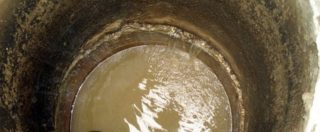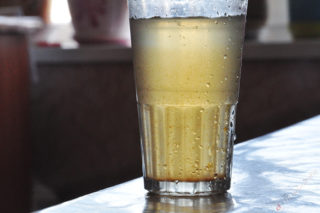Well water is a clear liquid that does not contain any impurities. Only small floods can cause its slight turbidity. However, having settled, it returns to its original state. However, if the water in the well is yellow, it is necessary to find out the reasons and eliminate them in order to avoid health problems and breakdowns of household appliances.
The main causes of yellowing water in the well
Color changes, the appearance of odors and other factors indicate the need to study water quality. Even if laboratory analysis shows its safety, measures must be taken to eliminate the causes.
- Yellowing is most often caused by an increased content of iron in bivalent or trivalent form. In the first case, the oxidation reaction can occur gradually. In this case, the water from the source is clean. After settling, it changes color and taste, and a reddish precipitate falls to the bottom of the tank.
- The sand-clay mixture falling from the aquifer can change not only the color, but also the composition of the water. These components may appear due to poor-quality sealing of the joints at the joints of the rings or with insufficient shaft depth and indicate siltation.
- If a well is dug in an area with peat bogs, substances formed during microbiological decomposition of plant and animal residues can enter it. Tannin, humic acids and other trace elements that form humus, dissolving, lead to the appearance of a yellowish tint. Moreover, the color intensity depends on their quantity.
- Lack of proper protective coating makes source clogging accessible. Precipitation, dust, falling leaves, as well as dead insects, decomposing and dissolving can color the water in any shades of yellow.
The reason for the color change of the liquid may be waste from industrial enterprises located near the source. In this case, a violation of the structure of the aquifer occurs, and it is impossible to predict the shade of water.
Dangerous effects
Yellow or rusty water in the well may be seasonal or year-round. But in any case, using it is unsafe.
- The presence of organic matter and debris is indicated by a musty smell and a specific taste. These components make the composition bacteriologically seeded. Use leads to disruption of the digestive tract, poisoning and infection.
- Problems caused by peat soils, as well as suspended sand or clay - do not entail any serious consequences. The only negative factor is the unpleasant visual and taste sensations.
- Exceeding the allowable amount of iron is harmful to people. Such a composition can not be used either for cooking or for sanitary and hygienic needs. Once an organism has entered, it enters into a chemical reaction with elements important for life and forms hazardous compounds.
- The ingress of effluents from industrial enterprises into drinking water can cause the development of any pathology, starting with allergic reactions and ending with cancer.
It is impossible to ignore the change in the color of water. Using it even after boiling can cause irreparable harm to human health. Therefore, this problem must be solved very quickly.
Ways to fight

It is impossible to determine the quality of the water in the source without taking samples and checking them in the laboratory. However, you can get rid of the rusty color and achieve transparency of the liquid yourself.
- It is easiest to clear the yellowing caused by peat bogs and sand and sand suspensions. To do this, seal the joints between the rings, completely eliminating the possibility of leakage. From the inside, they are coated with a sealant based on liquid glass, and a moisture-proof coating is applied from the outside. In addition, it is mandatory to clean the bottom layer with the removal of all compounds that can cause a color change.
- Iron removal in the presence of insoluble elements is not difficult to perform. To do this, at the exit from the well in front of the pump, a filter is mounted or a gravel cushion is equipped at the bottom of the source, capable of holding a large number of particles. If the volume of fluid used is small, you can achieve the desired result by settling. Soluble iron can only be removed by filtration or purification with forced aeration.
- If the water smells of hydrogen sulfide, it is necessary to clean the well, removing from it all the sludge formed there. After cleaning, the structure must be treated with ozone or hydrogen peroxide. This process can be dangerous, therefore it is better to entrust it to professionals.
There are many reasons for the appearance of yellow, so a thorough study of each specific case is required to solve the problem. Sometimes the color change is due to improperly installed pumping equipment. A unit located too close to the bottom sucks in its particles. In this case, just reinstall the device.
Preventative measures
In order to prevent yellowing of the contents of the well, it is necessary to conduct its annual examination to identify deformations of the intake shaft and to study the cleanliness of the bottom.
If leaky joints are found, repair work must be performed, after which the inner surface of the walls should be disinfected.
To purify water and reduce the content of bacteria in it, it is necessary to drain the tank from time to time and treat it with a solution of bleach. This element is dangerous to human health, so the dosage of the composition used must comply with SanPiN.




